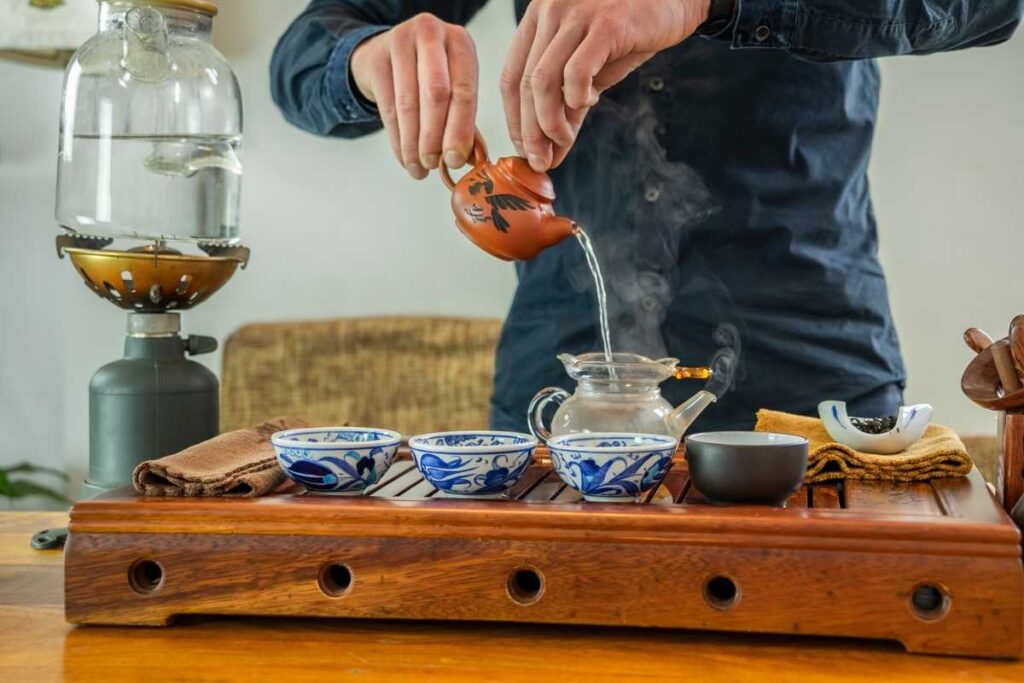Tea Tasting 101: Develop Your Palate & Host Parties

Ready to dive into the world of tea tasting? It’s not just about sipping on a cup of tea – it’s an art that requires mindfulness and attention to detail. As you explore different teas like Mansa Tea or Anna Ye Tea, you’ll learn that each type requires its own brewing method, such as using a gaiwan. Don’t forget to also try out different brewing methods for coffee, and enjoy your drink in your favorite mug or cups.
Tea tastings are a great way to expand your knowledge and connect with other enthusiasts while enjoying a delicious drink. But how do you get started? In this article, we’ll cover everything from what is tea tasting and how to do it, to finding the best gourmet boutique tea tasting experience near you. Whether you’re a food lover or just looking for online experiences, there’s something for everyone in the world of tea tastings. So grab your favorite tea leaves and let’s begin!
The Basics of Developing Your Tea-Tasting Palate
Developing your tea-tasting palate requires practice, and it’s not something that can be mastered overnight. It takes time to train your taste buds to identify different flavors accurately. To become an expert in tea-tasting, you need to drink a variety of teas regularly and pay attention to the smell and taste. Visiting a gourmet boutique and trying different teas can also help you develop your palate. In this article, we will discuss the essential elements of developing your tea-tasting palate.
Your Tongue and Mouth Play a Crucial Role in Detecting Flavors
Your tongue and mouth play an integral role in detecting flavors. The taste buds on your tongue are responsible for detecting the five basic tastes: sweet, salty, sour, bitter, and umami (savory). However, wine tasting teams often come up with new ideas and collaborate with their team members to identify more complex flavor profiles beyond these basic tastes.
The aroma of tea, like wine tasting, is detected by your olfactory senses through your nose. The texture or mouthfeel of tea, similar to classes, is detected by the touch receptors on your tongue. All these factors work together to create a complex flavor profile that makes each type of tea unique, just like how teams of people come together to taste and appreciate different wines.
Building a Vocabulary of Taste Descriptors Can Help You Identify Different Flavors
Building a vocabulary of taste descriptors can help you identify different flavors in tea accurately. Some common taste descriptors include floral, fruity, nutty, earthy, spicy, and woody. This is ideal for tea enthusiasts who want to explore different teams of tea. You can also use this for classes or kits that teach about tea tasting. By using specific words to describe the flavors you detect in tea, you can better communicate with others about what you’re tasting.
It’s also essential to note that everyone’s perception of taste is unique, especially when it comes to tea tastings. Quality tea is best appreciated through tea tasting kits and tea samples. What one person may describe as floral might be described as fruity by another person. Therefore it’s important to develop a personal vocabulary that accurately reflects how you perceive different flavors.
Paying Attention to Temperature, Brewing Time and Water Quality Can Affect the Taste Of Your Tea
Paying attention to temperature, brewing time and water quality can significantly affect the taste of your tea. Attending tea classes can help you learn the ideal brewing methods, and working in teams can improve your skills. For example:
- Water temperature: Different classes of teas require ideal water temperatures for optimal brewing results, which can vary depending on the teams of tea being brewed.
- Brewing time: Overbrewing or under-brewing tea can result in a bitter or weak taste. This is ideal for tea enthusiasts who attend classes and teams.
- Water quality: The quality of the water you use to brew your tea teams can affect its taste. It’s recommended to use filtered or bottled water for the best results.
Researching and Tasting Teas Beforehand
If you’re a tea enthusiast, you know that tea tasting is an art form. It’s not just about drinking tea; it’s about experiencing the flavors and aromas that each type of tea has to offer. To fully appreciate the nuances of different teas, it’s essential to research and taste them beforehand. When trying out new teas, it’s also helpful to have a group of tea-loving friends to form tea teams and share your thoughts with.
Researching Tea Types and Brewing Methods
Before you start your tea tasting journey, it’s important to do some research on the different types of teas available. There are hundreds of varieties of teas out there, from black teas to green teas to herbal infusions. Each type has its unique flavor profile, brewing time, and water temperature requirements.
Take some time to learn about the various types of tea and their brewing methods. For example, black teas typically require boiling water, while green teas should be brewed with water that’s around 175°F. Knowing these details will help you prepare your cup of tea correctly.
Familiarizing Oneself with Tea Flavor Profiles
Tea tasting involves more than just sipping on a cup of hot liquid; it requires an understanding of the flavors present in each type of tea. Take some time to familiarize yourself with the flavor profiles commonly found in different types of tea, ideal for those who want to appreciate the nuances of tea.
For example, black teas tend to have bold and robust flavors with notes of malt or caramel. Green teas are lighter in flavor with grassy or vegetal undertones. Herbal infusions can have a wide range of flavors depending on the herbs used but are generally caffeine-free.
Tasting Teas in a Controlled Environment
It’s ideal for best to do so in a controlled environment, which is perfect for eliminating any distractions that could interfere with your ability to focus on the taste and aroma of each tea.
Find an ideal space where you can sit down and concentrate solely on your cup of tea without any interruptions. This will be ideal for fully immersing yourself in the experience and appreciating the tea’s unique flavors and aromas.
Taking Notes on Brewing Times and Water Temperatures
To ensure that you’re brewing your tea correctly, it’s essential to take notes on the brewing times and water temperatures for each type of tea. This information will help you prepare your cup of tea perfectly every time.
Keep a notebook handy while you’re tasting different teas, and jot down the brewing time and water temperature used for each one. This will also come in handy when sharing your favorite teas with friends or family members.
How to Keep Tea from Tasting Bitter
One common issue that many people face when brewing tea is bitterness. To avoid this, make sure not to overbrew your tea or use water that’s too hot. For example, green teas should be steeped for no more than two minutes to prevent bitterness.
Enhancing your tea-tasting experience with friends
Tea tasting is not just a solo activity but can also be an enjoyable social experience. Inviting friends to join in can enhance your tea-tasting experience and make it even more fun. Similar to wine tasting, tea tasting is a great way to bond with others over a shared experience. Here are some ways you can make the most out of your tea-tasting experience with friends.
Experiment with different infusions and food pairings
One way to enhance the quality of your tea-drinking experience is by experimenting with different infusions and food pairings. You can try pairing different types of teas with complementary foods such as scones, biscuits, or cakes. For example, a strong black tea like English Breakfast goes well with rich chocolate cake while green teas pair perfectly with light snacks like cucumber sandwiches.
Tea Tasting as a Team-building Activity
Tea tasting can also be an excellent team-building activity for coworkers or team members. It’s a great way to break the ice and get people talking in a relaxed setting. You can organize an office tea party where everyone brings their favorite mug and share their experiences about their preferred blends.
Online Tea Tasting Experiences
With the pandemic still ongoing, online experiences have become increasingly popular, including virtual tea tastings. Many companies offer online tea-tasting sessions that you can enjoy from the comfort of your home with friends or family members living far away.
Experimenting With Different Types Of Teas
Another exciting aspect of hosting a tea-tasting party is trying out various types of teas available in the market. From green teas to herbal blends, there are many options available that cater to every taste bud preference.
Questions To Consider
If you’re wondering how to make better tasting green tea or how to make the best tasting iced tea, here are some tips:
- For green tea: use water that is not too hot (around 170°F) and steep for only a minute or two to avoid bitterness.
- For iced tea: use double the amount of tea leaves you would for a hot cup of tea, and let it steep for at least five minutes before adding ice.
Hosting a Successful Tea Tasting Party: Preparation and Snacks
Hosting a tea tasting party can be an enjoyable experience for both the host and guests. It’s a chance to try different types of teas, learn about their flavors, and socialize with friends. To ensure that your tea tasting event is successful, here are some tips on preparation and snacks.
Prepare a Variety of Teas to Cater to Different Tastes and Preferences
Tea comes in many varieties, each with its unique flavor profile. When hosting a tea tasting party, it’s essential to offer a diverse selection of teas that cater to different tastes and preferences. Consider including black, green, white, herbal, and fruit-flavored teas.
To make the selection process easier for your guests, provide them with information about each type of tea you’re serving. You can create small labels or cards that describe the flavor profile of each tea. For example, you could mention if it’s fruity or floral or has hints of spice or sweetness.
Offer Snacks That Complement the Flavors of the Teas Being Tasted
Snacks are an important part of any tea tasting party as they help cleanse the palate between tastings. However, not all snacks work well with every type of tea. For example, spicy foods may overpower delicate white teas while sweet treats may clash with bitter black teas.
When selecting snacks for your tea tasting event, choose ones that complement the flavors of the teas being tasted. Some examples include:
- Fresh fruit such as berries or sliced apples
- Cheese such as brie or goat cheese
- Nuts such as almonds or pistachios
- Crackers or bread
- Chocolate
Create a Welcoming Atmosphere by Decorating the Space and Providing Comfortable Seating
The atmosphere is another critical factor in hosting a successful tea tasting party. To create a welcoming environment for your guests:
- Decorate the space with flowers or candles
- Use tablecloths and cloth napkins instead of paper ones
- Provide comfortable seating, such as chairs with cushions or pillows, for your open door tea gatherings, mindfulness tea sessions, fine tea tastings, and virtual tea tasting classes.
By offering open door tea and providing virtual tea tasting classes with our tea tasting kits, guests can experience the cozy and inviting atmosphere of Mansa Tea from the comfort of their own homes. This way, they will feel more relaxed and enjoy the virtual tea tasting experience.
Virtual tea tasting ideas for groups
Looking for a fun and unique way to connect with friends, family, or coworkers? Look no further than virtual tea tastings! With the rise of online communication platforms, it’s easier than ever to enjoy a cup of tea with others from the comfort of your own home. Here are some ideas for hosting a memorable virtual tea tasting experience.
Tea Tasting Kits
One of the best ways to enhance your virtual tea tasting is by shipping out pre-made tea kits to all participants beforehand. These kits can include a variety of teas from different regions or types, along with instructions on how to brew them properly. This not only adds an extra layer of immersion but also ensures that everyone has access to the same teas during the tasting.
Customization
When planning your virtual tea tasting, consider customizing it based on the preferences and interests of your group. For example, if you’re hosting a team-building event, you could focus on teas that promote relaxation and stress relief. Alternatively, if you’re hosting a bridal shower or birthday party, you could choose teas that pair well with desserts or other snacks.
Tea Regions
Another idea is to explore different tea regions during your virtual tasting. You could choose teas from China, Japan, India, or even Africa and learn about their unique flavors and brewing methods. This is a great way to expand your knowledge and appreciation for different types of teas while connecting with others over shared experiences.
Tea Processing
If you’re interested in learning more about how tea is made, consider focusing on different processing methods during your virtual tasting. For example, you could compare black teas that have been fully oxidized versus green teas that have been minimally processed. This provides an opportunity to taste how processing affects flavor profiles while also learning about the history and culture behind each type of tea.
Pairing Teas with Food
Finally, consider pairing your teas with different foods during your virtual tasting. This can be a fun and interactive way to explore how flavors complement and contrast each other. For example, you could pair a floral tea like jasmine with light, fruity desserts or a smoky black tea like lapsang souchong with savory snacks like cheese and crackers.
Tea-tasting techniques: smell, taste, and appearance
Tea tasting is an art that requires the use of your senses. It involves evaluating the aroma, flavor, and appearance of brewed tea. In this section, we will discuss the tea-tasting techniques that involve using the senses of smell, taste, and appearance.
Smell
The aroma of tea leaves can provide valuable information about its quality. Before brewing the tea leaves, take a moment to sniff them to evaluate their aroma. The nose can detect subtle aromas that may not be apparent in the brewed tea. This step is crucial as it allows you to identify any off-notes or unpleasant smells before brewing.
Taste
Tasting notes are used to describe the flavor and aroma of tea. When tasting tea, take a small sip and let it sit on your tongue for a few seconds before swallowing. Pay attention to how it tastes on different parts of your tongue as different taste buds detect different tastes such as sweet, sour, salty or bitter. Tasting notes often include words like floral, earthy or fruity to describe the flavors present in the brew.
Appearance
The appearance of brewed tea can also provide clues about its quality. The color should be consistent throughout with no cloudiness or sedimentation visible in the liquid. The brightness of color also indicates freshness – brighter colors tend to indicate fresher teas while duller colors indicate older teas.
The Joy of Discovering New Teas Through Tasting
Congratulations! You are now equipped with the basics of developing your tea-tasting palate, researching and tasting teas beforehand, enhancing your tea-tasting experience with friends, hosting a successful tea tasting party, and exploring virtual tea tasting ideas for groups. By mastering the art of tea-tasting techniques such as smell, taste, and appearance, you can now enjoy the endless possibilities of discovering new teas.
So why not take a step further and challenge yourself to try new flavors? Expand your knowledge by trying out different types of teas from various regions. Share your newfound appreciation for tea with others by hosting a tea-tasting party or joining a local tea club.
Remember to trust your senses. Don’t be afraid to experiment and have fun while doing so. With these tips and tricks in mind, you can now embark on an exciting journey towards discovering the world of teas.
Happy sipping!




